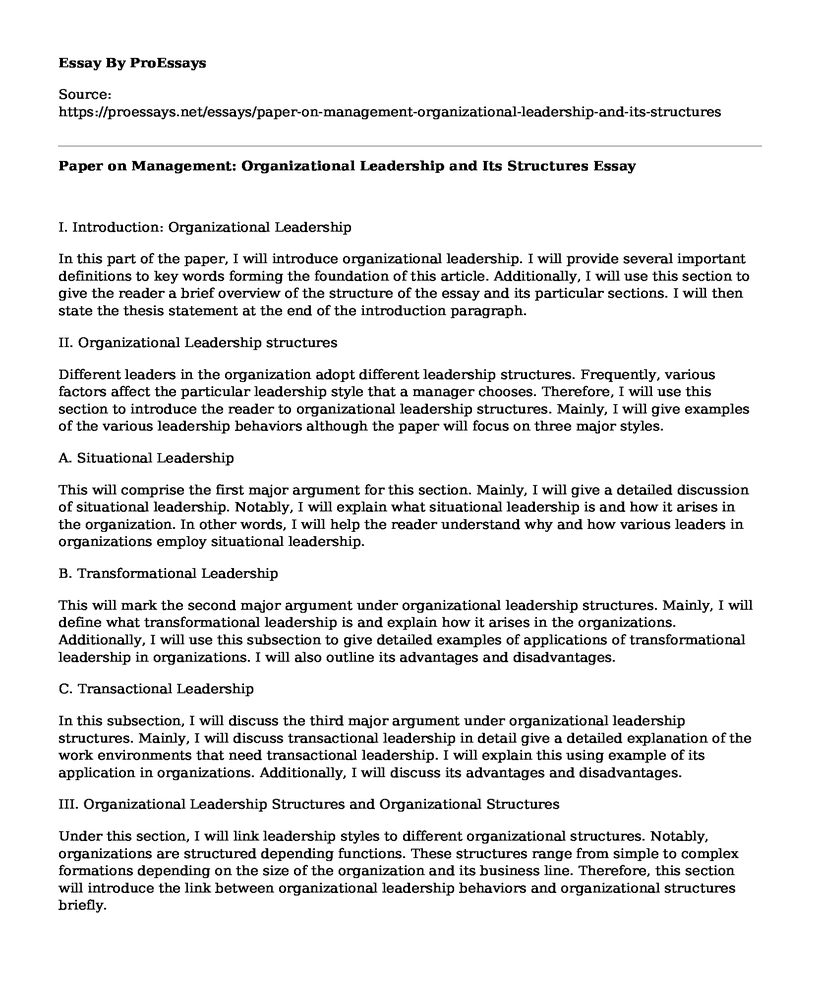I. Introduction: Organizational Leadership
In this part of the paper, I will introduce organizational leadership. I will provide several important definitions to key words forming the foundation of this article. Additionally, I will use this section to give the reader a brief overview of the structure of the essay and its particular sections. I will then state the thesis statement at the end of the introduction paragraph.
II. Organizational Leadership structures
Different leaders in the organization adopt different leadership structures. Frequently, various factors affect the particular leadership style that a manager chooses. Therefore, I will use this section to introduce the reader to organizational leadership structures. Mainly, I will give examples of the various leadership behaviors although the paper will focus on three major styles.
A. Situational Leadership
This will comprise the first major argument for this section. Mainly, I will give a detailed discussion of situational leadership. Notably, I will explain what situational leadership is and how it arises in the organization. In other words, I will help the reader understand why and how various leaders in organizations employ situational leadership.
B. Transformational Leadership
This will mark the second major argument under organizational leadership structures. Mainly, I will define what transformational leadership is and explain how it arises in the organizations. Additionally, I will use this subsection to give detailed examples of applications of transformational leadership in organizations. I will also outline its advantages and disadvantages.
C. Transactional Leadership
In this subsection, I will discuss the third major argument under organizational leadership structures. Mainly, I will discuss transactional leadership in detail give a detailed explanation of the work environments that need transactional leadership. I will explain this using example of its application in organizations. Additionally, I will discuss its advantages and disadvantages.
III. Organizational Leadership Structures and Organizational Structures
Under this section, I will link leadership styles to different organizational structures. Notably, organizations are structured depending functions. These structures range from simple to complex formations depending on the size of the organization and its business line. Therefore, this section will introduce the link between organizational leadership behaviors and organizational structures briefly.
A. Functional Organizational Structure
The functional organization structure will form the first major argument under this topic. Mainly, I will define the structure and give a detailed description of its application. Additionally, I will identify the best leadership style that fits the functional organizational structure by enumerating its benefits to such a structure.
B. Divisional Organizational Structure
A divisional structure is typical in large companies operating in a wide geographical location. Mainly, I will explain how such a structure may lead to efficiency in the attainment of goals but hamper teamwork in the organization. Therefore, I will link the best leadership style to the divisional organizational structure that will improve collaboration.
C. Matrix Organizational Structure
This will mark the final major argument under this topic. I will define and explain matrix organizational structure under this part. Mainly, I will link this structure to power struggles in organizations following dual management. Therefore, I will apply various leadership styles that will best suit to this organization chart and solve this problem.
IV. Effect of Organizational Leadership on Organizational Performance
Notably, corporate leadership contributes significantly to organizational performance. Under this topic, I will introduce the various major arguments that measure organizational performance and link them to different leadership structures. Under this section, I will restate that corporate performance is essential for any organization that intends to gain and retains a competitive edge in the industry.
A. Employee Satisfaction
Employee satisfaction will form the first major argument under this section. Notably, I will make it clear that employees comprise the most valuable resource for any organization and that their satisfaction is crucial to the overall organizational performance. Therefore, I will discuss how different leadership structures contribute to employee job satisfaction.
B. Innovation and Creativity
Notably, for an organization to be a high performer, it must keep introducing new ideas into its operations. Particularly, it will have to uphold innovation and creativity through the creation of responsibility opportunities among employees. Therefore, I will use this subtopic to link leadership styles to innovation and creativity, and finally, its contribution to organizational performance.
C. Goal-Oriented Work Environment
Under this argument, I will explain how challenging goals contribute to organizational performance. Particularly, I will restate that good leadership styles create work environments that link work to employees talents by aligning challenging goals that keep them motivated to work. I will then discuss how such goal-oriented work environments contribute to the overall organizational performance.
V. Conclusion
In my conclusion, I will restate several significant points from the previous sections to lead into my thesis statement stated in the introduction paragraph. I will give a quick review of the points in support of the thesis statement. I will also give a concession that opposing views may have a good argument. This admission and proof will lead to the restatement of the thesis to end the essay.
Cite this page
Paper on Management: Organizational Leadership and Its Structures. (2021, Apr 12). Retrieved from https://proessays.net/essays/paper-on-management-organizational-leadership-and-its-structures
If you are the original author of this essay and no longer wish to have it published on the ProEssays website, please click below to request its removal:
- Boundaries with Peers, Supervisors, and Subordinates in the Workplace
- Global Jurisdictions Affect Decision Makers in Balancing Social Economic Interests With Environmental Interests?
- Good Leadership, Criminal Justice & Social Contract Theory - Essay Sample
- Paper Example on Bad Decision Made, Good Lesson Learned
- Paper Example on Women's Leadership: Can They Reach The Top?
- Report Sample on Coca-Cola's Growth: Current Strategies and Actions
- Leadership in Action - Essay Sample







